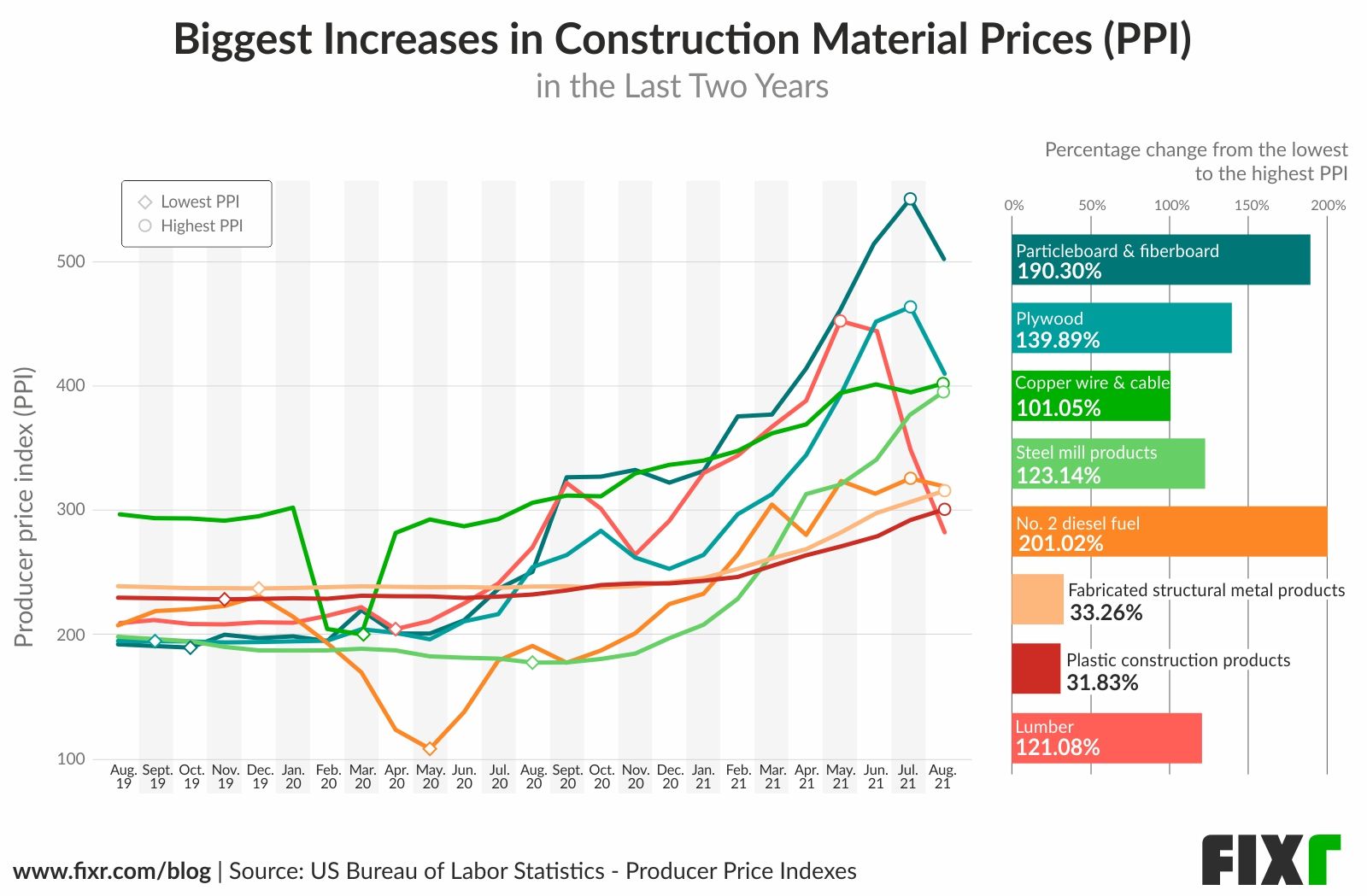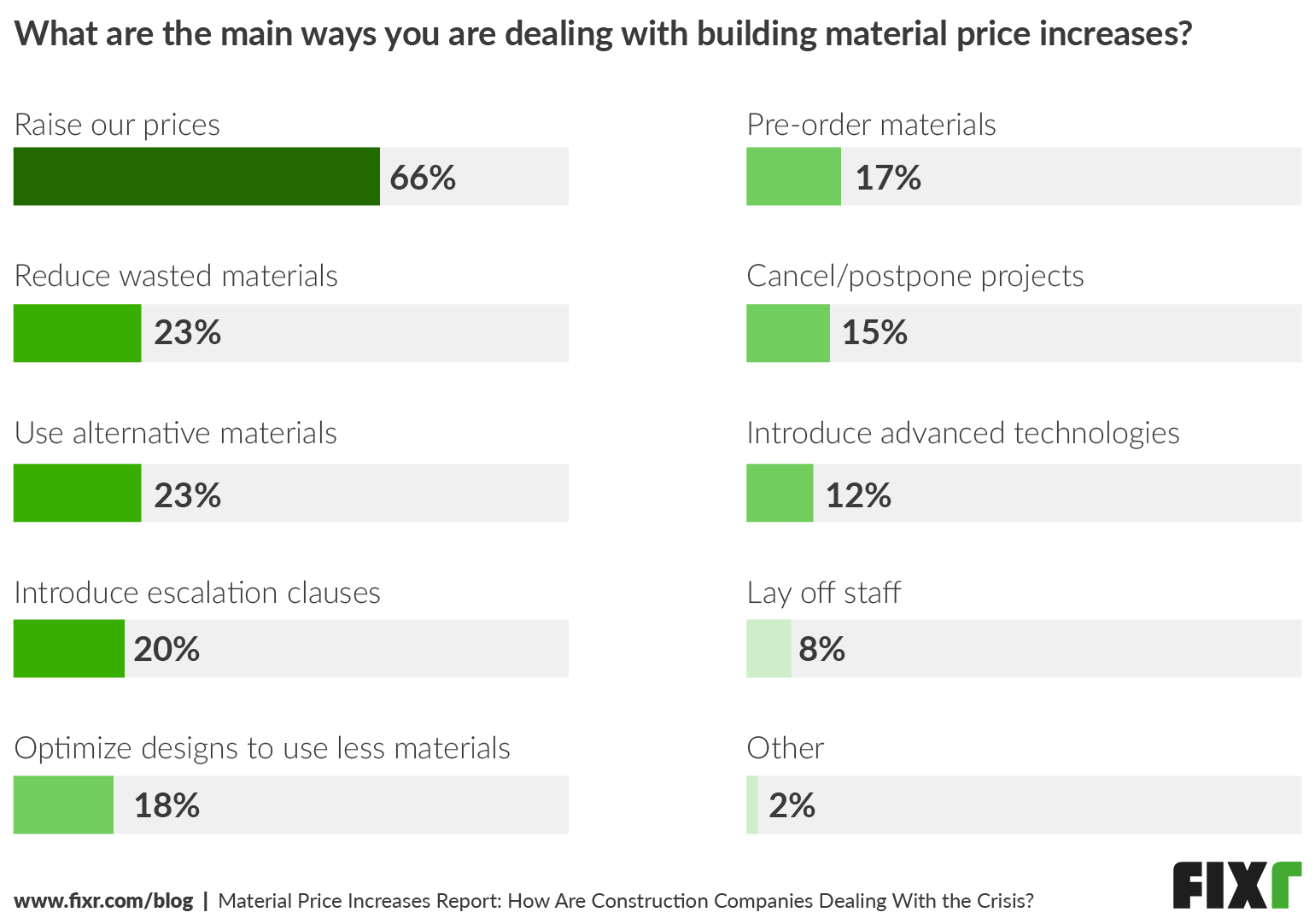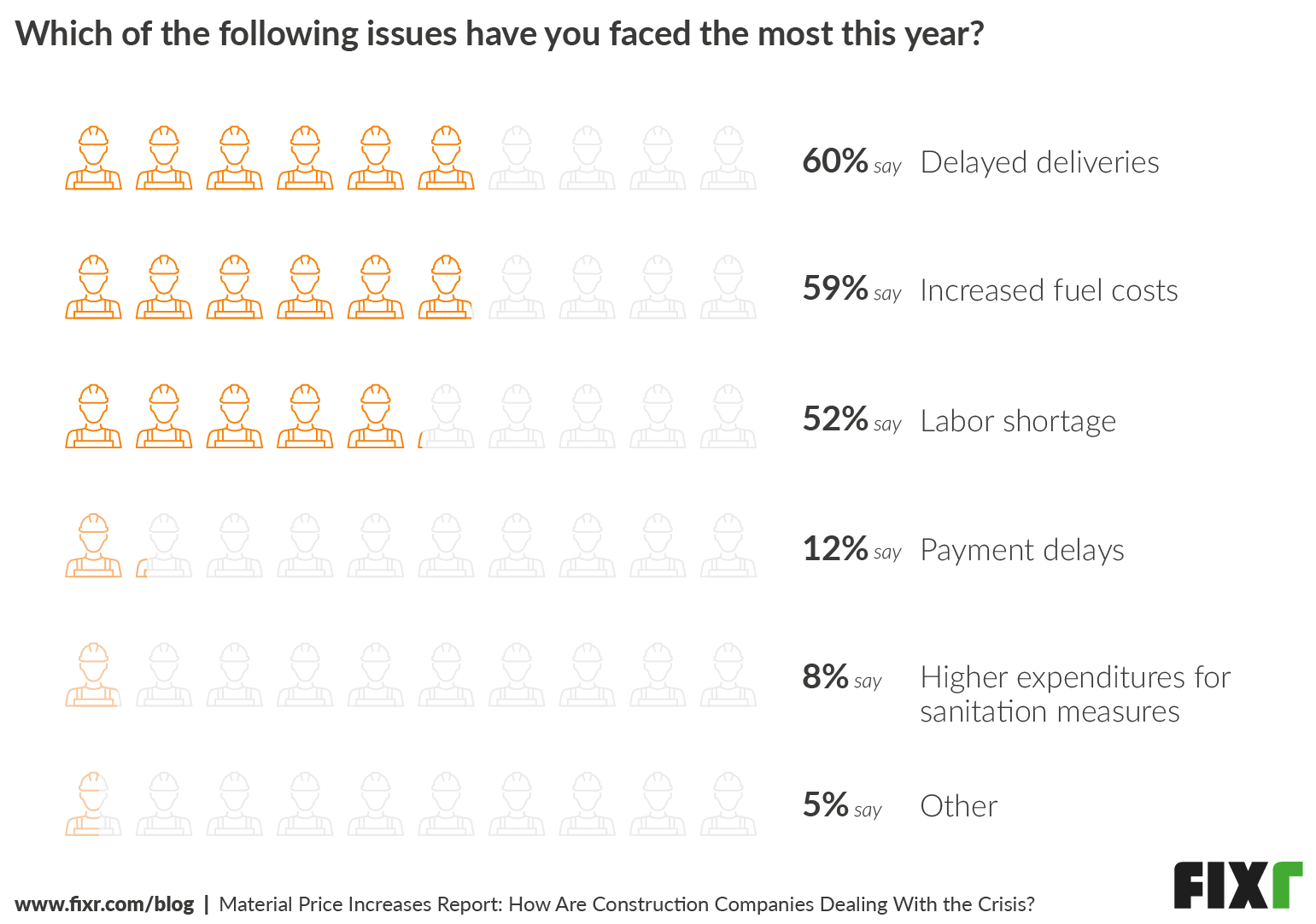Over the past two years, home building materials have increased in price, forcing businesses and construction professionals to find ways to cope and deal with the resulting effects. A strong demand for housing during 2020 drove intense competition among buyers, which caused homes to fly off the market quickly and pushed prices higher. Also, many homeowners chose to renovate their homes because they either had spare time to carry out DIY remodels or to accommodate their new way of living, schooling, and working. All these factors, among others, caused a surge of builders to flood the building material market. This, coupled with shutdowns and labor shortages, significantly increased the prices of those building materials.
This report aims to draw awareness to the various challenges facing the construction industry, the resulting effects, and what it could mean for homeowners. We conducted a survey of 100 construction companies and professionals in varying areas of home construction and remodeling to gain an insight into what they are doing to meet the challenges of material price increases. Data on prices for building materials from one year before the pandemic (2019) until current times were analyzed and are included in the below graphic to help detail the extent of the situation.
In this report:
- Biggest Increases in Construction Material Prices
- Ways to Cope: 66% of Companies Are Raising Their Prices
- Biggest Issues: Over 50% Have Faced Labor Shortages
- Main Effects: 61% of Companies Have Suffered Project Delays
- Predictions and Outlook for 2022
- Methodology
Greatest Increases in Construction Material Prices
The below graphic depicts some of the most important materials with the largest percentage change in Producer Price Index (PPI) over the last two years, shown with the lines. The bars on the right highlight the percentage change from their lowest PPI point to their highest, showing the extreme fluctuations that have taken place.

The PPI is the most accessible single-source resource on construction material prices and represents the average movement in the selling price charged by producers as the product leaves their factory gates. While not perfect and sometimes lagging by a month or two, they are the best data available today for understanding this complex issue.
To choose the materials shown, we analyzed more than 30 construction materials and chose a list of the eight we believe are more illustrative of this crisis, whether because they suffered the highest increases or their importance in the construction industry. It is important to note that many other materials have been affected but are not depicted in this graphic.
Overall, No. 2 diesel fuel and particleboard and fiberboard products increased the most from their lowest to highest point during this time frame by 201.02% and 190.30%, respectively. Both lumber and plywood increased over 100% in the same time frame (121.08% and 139.89%, respectively). Other notable materials that saw huge increases were steel mill products (123.14%) and copper wire and cable (101.05%).
Diesel fuel's use in the construction industry is predominantly tied to transportation. This includes the transportation of other materials to lumber yards, suppliers, and job sites. This fuel is also used to power heavy equipment, such as excavators and bulldozers, making it more expensive to run these machines. In turn, this can impact the cost of projects like land clearing and site prep.
Particleboard and fiberboard have numerous uses in the industry, some of which are tied to plywood. They can be used to create cabinets, furnishings, built-in bookcases and entertainment centers, and surfaces for a wide variety of areas in and around residential buildings. Lumber and plywood both also fall into this category, but these materials can be used in many ways that particleboard and fiberboard cannot because the two former materials cannot handle the same amount of exposure to moisture. Lumber, in particular, is used for framing, while plywood may be used as exterior sheathing.
Steel and copper are two materials with a long history of varying costs. They are used in building frames, pipes, electrical wiring, and numerous other areas. While their fluctuating costs have led some professionals to look at other materials to replace them, steel and copper are often preferred for things like steel framing and copper pipe by professionals and homeowners.
The Main Ways Professionals Are Dealing With Price Increases

To better understand the real issues professionals face and their tools and solutions to cope with this trying period, we asked home improvement professionals (homebuilders, remodelers, and other professionals in the construction industry) to share their thoughts and experiences.
Homebuilders have taken a multi-prong approach to dealing with the building material price increases. When asked to choose between one and three options, the majority of homebuilders we surveyed said that the main way they are coping with higher costs is by increasing their prices to cover it. 66% of respondents revealed they have raised their prices accordingly.
A certain number of construction professionals say that they have focused on the way they use the materials. 23% told us they are using alternative materials. This way, they can do the same job but at a more acceptable price. Yet, this could entail benefits or drawbacks depending on the replacement material chosen, which may not be applicable for all projects. Another 23% share that they are reducing their waste of materials to maximize the bang they get for their buck.
Many are including price escalation clauses in a fixed-price contract. 20% shared that they have introduced these clauses to deal with the price hikes of materials. Whereas these clauses can protect them from rising prices, they may also lead to lost contracts if homeowners are not willing to take on the risk of a potential price change mid-project.
Optimizing designs to use fewer materials is one approach that 18% say they are using. Some are pre-ordering and paying for lumber at today's price, especially now that it has decreased substantially since its record high, in the fear that prices could rise again. 17% of respondents use this method to help guarantee the price remains level for the duration of any projects on the books. But it requires money upfront and a risk of prices falling in the future. For those who are not pre-ordering, many are opting to secure price guarantees from their suppliers for a period of time.
Only 15% of homebuilders have cancelled or postponed projects as a way of dealing with the issue, and 12% have opted for using advanced technologies. 8% reveal they have had to lay off staff. 2% state they have used a different approach, such as Jessica at Marketplace Homes who says, "Increasing communication with clients to help manage their expectations when it comes to the cost of their new construction homes as well as preparing them to expect possible delays in the completion of their new construction home."
Issues Professionals Have Faced the Most

As well as the increase in prices of materials, homebuilders have faced other issues. When asked to reveal one to three issues they faced the most this year, 60% of the respondents say delays in deliveries, and 59% say increased fuel costs.
With a high demand for products combined with the 52% who say labor shortages have been a major issue, it is no wonder that there have been delays. Don Adams, general manager of Regional Foundation Repair, sheds light on this issue further by stating, "As prices for lumber and other building materials have risen, demand for the likes of concrete and cement has risen, putting a strain on resources. This is creating a knock-on effect in the whole construction industry. Projects are becoming delayed, stressing customers and contractors alike." Phillip Ash, founder of Pro Paint Corner, draws on the fact that time spent at home ultimately created the issue of delays by saying, "We're seeing increasing costs of paint due to shortages in key ingredients to make paint, as well as increasing demand for paint. More people who are spending time at home have become increasingly interested in home renovation projects. With delays in the supply chain, we can expect this trend to continue."
12% who responded to the survey also share that there has been a delay in payments, complicating the situation even further for companies, and 8% declare increased expenditure on sanitation measures has been a major issue.
The Main Effects of this Materials Crisis

When asked about the main effects of this crisis on their business activity, 61% of contractors agreed that project delays due to material shortages were the main issue. According to our survey, the majority of homebuilders may not be postponing or cancelling projects, but 61% say they are seeing delays due to material shortages.
Jeff Shipwash of Shipwash Properties LLC says, "With the substantial demand for housing, supply is still trying to catch up in 2021. In addition, the continued shortage of certain components is resulting in continued increases in prices to certain materials. In my opinion, this will need to be managed for the long term as I don't foresee a sharp decline in demand or shortages anytime soon."
Whereas the pandemic and the huge demand have had a big effect on delays and shortages, other recent incidents have been affected, too. One contractor who wished to remain anonymous claims, "One of the main factors is the extensive damage caused by the hurricanes affecting the east coast. Any material used to build doors, roofs, and windows will be affected by these issues, prompting delays to rebuild the affected areas and increasing prices all across the country."
Due to the many issues occurring as a result of material price rises, 36% say that clients postponing or cancelling projects is one of the main effects they have experienced, and 28% share that their clients have been modifying or lowering the project scope to deal with the added cost they may not have budgeted for.
How Are Homebuyers Dealing With the Increases?
Homebuyers are also directly affected by these rises in material costs as housing affordability becomes harder to achieve. Between May 2020 and May 2021, a record high home price increase of 13.2% occurred. Some cities have seen even higher jumps, like Austin, TX, which was up 30.5% over the same time period.
As of this article's publishing, interest rates still remain historically low. This translates to homebuyers being able to borrow more money than they may be able to at higher rates, meaning being able to afford a higher-priced home. Unfortunately, even with low interest rates, if buyers do not have enough funds for a down payment or an appraisal value comes in too low, they may still be priced out of the home or unable to obtain funding.
For those who already own their home and are considering a renovation, the fact that many home improvement plans in the U.S. have been delayed, because of shortages and rising material costs, may leave homeowners considering whether they should delay a project until next year.
Predictions for Future Costs
The Delta strain of the COVID-19 virus has thrown another wrench into the volatility of the market, and the jury is out on what the future holds for the material cost crisis the U.S. is currently experiencing. However, there is optimism in the air. As homeowners have been scaling back on projects and new home builds have slowed, lumber mills have ramped up production and are righting the temporary mismatch in supply and demand. Many experts and the Federal Reserve believe that the price increases, for lumber as well as a range of products, experienced in the past year will diminish as the economy returns to normal.
Yet, some construction workers we spoke to are still skeptical about what will happen to the cost of certain materials. When asked which other materials will start rising in cost, Warren Byington of Backyard Brothers LLC believes that, "Concrete and concrete products; steel; especially due to the zeroing in on such materials as they relate to climate aspects," and Ben Neely of Riverbend Homes noted that, "Windows, and metal roof materials have increased steadily."
Outlook for the Industry
Many agree that the repercussions of what we have seen over the past two years could be long-lasting. One anonymous construction worker told us, "I will probably go out of business because I can't raise my prices accordingly." Don Adams predicts that, "It is foreseen that in 2022 lumber prices will drop again to pre-pandemic levels, but until then contractors will not have the work they need to keep their businesses afloat." And Sarabeth South, home design expert for Fixr.com, also sees more challenges ahead by stating, "Given the labor shortages, I predict that the biggest cost increase in the future will be labor, rather than materials."
Not everyone agrees that the outlook is so negative, though. Gregg Cantor, President/CEO of Murray Lampert Design, counts himself lucky saying, "We are fortunate to be in a city where the material increases have not affected us. There is a shortage of housing in San Diego and property values continue to rise. I think we have seen the worst of material increases and shortages."
Both homebuilders and homebuyers are facing unprecedented price increases in building materials as one of the many ramifications of the pandemic. Hopefully, the next few months will shed some light on whether prices will return to normal and what we can expect for building projects moving forward. As our graphic shows, some of the materials that have seen the biggest increases in price are beginning to decline. Only time will tell if prices will remain unpredictable or if things can begin to return to some normality as we approach 2022.
Methodology
Construction Material Prices Graphic: Fixr.com's editorial team gathered PPI data on different construction materials from the Bureau of Labor Statistics. We analyzed a list of more than 30 materials and their price increases and decreases during the last two years and made a selection of the eight we decided were representative enough of the crisis, taking into account both their high increase in PPI and also their importance in the industry. We then calculated the percentage change from their lowest point to their highest, noted in the line chart, from August 2019 until August 2021. These eight materials aim to be an illustration of the crisis, not an exact and thorough representation.
Survey: Our survey was sent to professionals and companies currently working in the home construction industry in varying sectors. Most are listed as contractors on the Fixr.com website. They were asked to respond to a range of open-ended and multiple-choice questions, some of which allowed for between one and three options to be chosen. The 100 respondents were told that their answers would remain anonymous to gain maximum sincerity unless they gave permission for their answers to be cited.